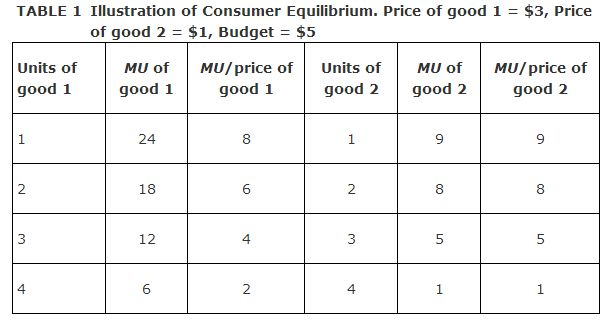Consumer Equilibrium Changes in Prices
The consumer's choice of how much to consume of various goods depends on the prices of those goods. If prices change, the consumer's equilibrium choice will also change. To see how, consider again the example considered above where the consumer must decide how much to consume of goods 1 and 2. Suppose that the price of good 1 increases from $2 per unit to $3 per unit, while the price of good 2 remains unchanged at $1 per unit. Everything else remains the same; the consumer's budget is still $5, and the marginal utility that the consumer receives from each additional unit of goods 1 and 2 is unchanged. However, the ratio of the marginal utility of good 1 to the price of good 1 is now changed, due to the increase in the price of good 1. The new situation is reported in Table .

The increase in the price of good 1 to $3 lowers the marginal utility per dollar spent on good 1 relative to the case where the price of good 1 was $2. The new consumer equilibrium is found as before, by comparing the marginal utility per dollar spent on good 1 with the marginal utility per dollar spent on good 2. The consumer's new equilibrium choice is to consume 1 unit of good 1 and 2 units of good 2 because these quantities have the same marginal utility per dollar spent, and the purchase of these quantities completely exhausts the consumer's budget of $5.
The effect of a price change on the consumer's equilibrium choice is often divided into two effects—known at the substitution effect of a price change and the income effect of a price change.
Substitution effect of a price change. When the price of a good changes, the price of that good relative to the price of other goods also changes. Relative price changes cause consumers to substitute from one good to another—this is known as the substitution effect. The substitution effect is illustrated in the example considered above. As the price of good 1 rises from $2 to $3, good 1 becomes more expensive relative to good 2, and good 2 becomes less expensive relative to good 1. The consumer's response to the price increase is to substitute her consumption away from good 1 and toward good 2; she changes her consumption choice from 2 units of good 1 and 1 unit of good 2 to 1 unit of good 1 and 2 units of good 2.
Income effect of a price change. The income effect takes account of how price changes affect consumption choices by changing the real purchasing power or real income of the consumer. In the example above, the increase in the price of good 1 from $2 to $3 reduces the consumer's real purchasing power. Prior to the price change, the consumer was able to purchase 2 units of good 1 and 1 unit of good 2 using her budget of $5. After the price of good 1 rises to $3, the consumer is no longer able to purchase this same bundle of goods because it would cost $7 and she has only $5. Accordingly, she must reduce her expenditures. The portion of her change in the consumption of good 1 that is attributable to the change in her real purchasing power or real income is the income effect of the price change.